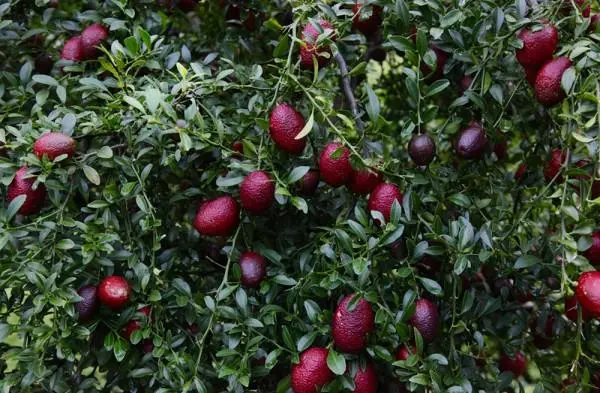Contents
Citruses are a special genus of plants that are cultivated on an industrial scale. Among the variety of citrus fruits, lime occupies a prominent place. It is a fruit that is genetically similar to a lemon. On the basis of the species, various hybrid varieties with special varietal characteristics have been developed. Blood lime is a hybrid that has spectacular external characteristics and special taste qualities.
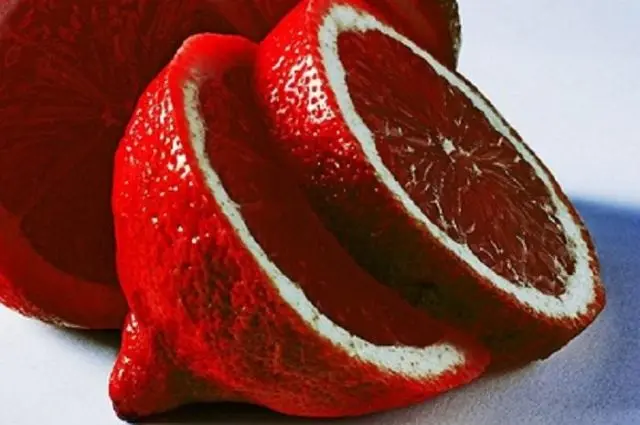
What does a blood lime look like?
A red variety appeared on the territory of Australia in early 1990. According to the researchers, at the stage of pollination there was a mixture of pollen from wild finger lime and red Cantonese lemon. The result was a fruit known as the “Australian blood lime”.
The first years of its existence, the red fruit was grown as an ornamental shrub. Ripe limes look especially impressive when arranging personal plots. Photos of blood lime shrubs always impress designers and gardeners. The first commercial harvest of red blood lime was in 2004.
The shrub grows on soils characteristic of a subtropical climate. The tree develops slowly, has some features.
- The branches of the shrub hang down, dark green leaves serrated along the edges densely develop on them. The leaf axils form short, sharp spines. The height of the shrub reaches 2,5 m;
- The flowers of the plant are medium in size, white or pink-cream. When flowering, they emit a faint lemon scent;
- The fruits are shaped like classic lemons, their length reaches 5 – 8 cm, width – 3 – 4 cm. Their peel is thin, bright orange, red or cherry – at the time of technical ripeness. The pulp of the fruit is located in segments that differ in shape from the usual citrus fruits and acquire a red tint as they ripen. Dense and juicy, it tastes like sweet and sour.
The juice that is squeezed out of a red lime acquires redness of varying intensity. The aroma of the pulp resembles grapefruit. The pulp segments contain dense seeds.
The composition and nutritional value of the hybrid
Blood lime is considered low-calorie. By the composition of the fruit, one can judge the benefits of the hybrid: the water part is about 87%, about 10% – carbohydrates, 1% – protein and fat.
The fruits of red bloody citrus are rich in useful substances:
- pantothenic, citric, ascorbic acids;
- riboflavin;
- choline;
- anthocyanin;
- niacin;
- carotene;
- thiamine;
- nicotinamide;
- phytoncides;
- trace elements: potassium, phosphorus, iron.
In addition, citrus contains essential oils characteristic of the species, as well as sucrose, organic acids.
How many calories in red lime
The fruit of red bloody citrus is low in calories: 100 g of pulp has an indicator of 30 kcal. This quality of citrus is often used to prepare dietary dishes, as the basis for numerous unloading diets.
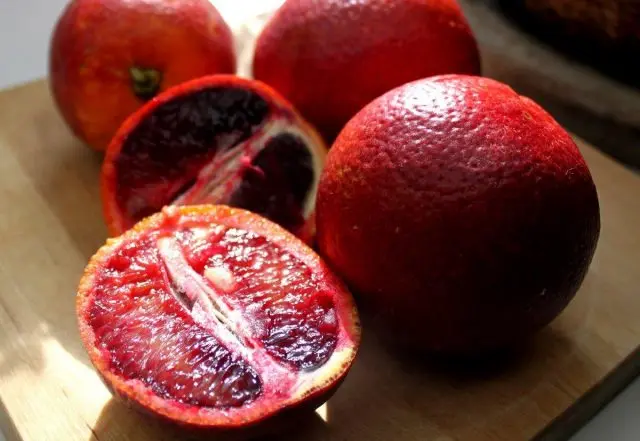
Benefits of blood lime
The unique composition of the hybrid citrus makes it useful and in demand.
- The pulp of the fruit is used for colds as a remedy that can replenish the supply of vitamin C, and also helps to increase the body’s defenses.
- Phytoncides have a bactericidal effect, which manifests itself in the normalization of natural processes occurring at different levels: the removal of inflammation, preventing the penetration of infections.
- Micro and macro elements in the composition of the product help to improve vision, strengthen the optic nerve, and have a positive effect on the general condition.
- Acids, as well as organic substances, activate the natural production of collagen and elastin. This has a positive effect on the condition of the skin and hair.
- Anthocyanins, nianocytes are involved in the stabilization of metabolic processes in the body. This affects overall health.
Citruses of this variety are able to replenish the forces expended after physical exertion, increase the water balance to a normal level.
Limitations and contraindications
Despite the beneficial properties, the unique composition of red citrus can have harmful effects on the body. It should be used with caution in diseases of the intestines, pancreas, liver and kidneys.
Acids activate the production of gastric juice, so they may be contraindicated in case of increased acidity. The period of exacerbation of an ulcer or gastritis is a direct contraindication for the use of citrus fruits. The furocoumarins that the pulp contains can cause an allergic reaction.
How to eat a bloody Australian lime
All parts of the blood red citrus are used in cooking. They are used as an additive to tea, salads, marinades, second and first courses. The peculiarity of the application lies in the fact that the pulp cannot be cut into circles or segments, as is done with other varieties of citrus fruits. Cut a red lime in half and scoop out the pulp with a spoon.
The skin of the fruit is thin and fragrant. In many countries of the Middle East, it is used to add to various dishes.
Red citrus is not offered to children under 6 years of age, and is also not recommended for pregnant and lactating women due to the risk of developing allergic reactions.
What is made from red lime
Lime red is not as common as the classic green variety. This is due to the difficulties of transportation and growth characteristics only in the subtropics. The red variety is more suitable for culinary use than the green fruit because its flavor is more varied.
Dish recipes
Lime is included in the preparation of the most unusual dishes. It goes well with seafood, meat, vegetables.
salted salmon
Ingredients:
- salmon fillet – 800 g;
- lime red – 3 pcs.;
- sea salt – 4 tbsp. l.;
- sugar – 2 st. l .;
- pepper.
Zest, as well as dry ingredients are mixed. The mixture is distributed along the bottom of the salting container, the prepared fillet is laid out on top, which is sprinkled with red citrus juice, and then covered with a film. Put in the cold for 24 hours. Then the fillet is washed, dried with a towel before use.
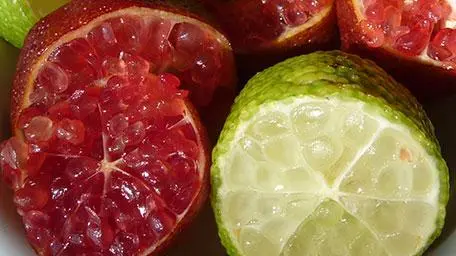
Mexican salad
Canned beans, cherry tomatoes, red onion are cut into rings, avocado pulp is mixed in a bowl. Then add red lime segments, olive oil, salt and pepper to taste. Salad should be infused for about 2 hours.
lime marmalade
The juice of one lime, its segments are mixed with 1,5 tbsp. sugar and 0,5 tbsp. water. The mixture is boiled over low heat, with the addition of a small amount of gelatin. After cooling, marmalade is poured into molds and removed for freezing.
Baked fish
Sea fish fillets are rubbed with a mixture of salt and pepper, then lime eggs are added. The fish is wrapped in foil, then baked on coals.
Marinade for meat
Juice, pulp of 3 red limes, juice of 1 lemon are mixed with salt, pepper to taste, sprigs of rosemary, dried herbs are added at your discretion. Rub the meat fillet with the mixture and leave it for 2-3 hours. Roast meat or bake on coals.
Refreshing drink recipes
Especially popular are drinks made from the pulp and juice of red citrus. For drinks, not only the taste is important, but also the color of the lime.
refreshing tea
Tea leaves are brewed in the usual way, then crushed red fruit pulp and zest are added. The tea drink is cooled, a sweetener is added, served on the table after straining.
Mai-Thai cocktail
Rum is mixed in a shaker with pulp and blood lime juice, curacau syrup is added and mixed again. Served with mint leaves, garnished with pineapple slices.
Juice
The juice of lemon, red lime, orange is mixed in equal amounts. Served with ice cubes.

Alcoholic drink
Tonic, gin, lemon juice are complemented with red lime pulp caviar. When serving, add ice, a circle of orange.
Lemonade
Mineral water is mixed with sugar, lemon juice. Add a few tablespoons of red lime pulp. Served with ice.
Sauces
Lime sauces are suitable for seafood, as well as meat or poultry dishes.
vietnamese hot sauce
- white pepper – 4 tsp;
- black pepper – 6 tsp;
- juice of 1 lime.
Freshly ground pepper is used for the sauce. It is mixed with lime juice until smooth. Salt is added if necessary. This sauce is served in a separate cup with baked meat or fish cooked on coals.
Fish sauce
Olive oil, soy sauce, blood lime juice are mixed until smooth. Separately combine chopped garlic, lime pulp, chopped basil leaves. The mixtures are allowed to infuse for 30 minutes. Served with fish.
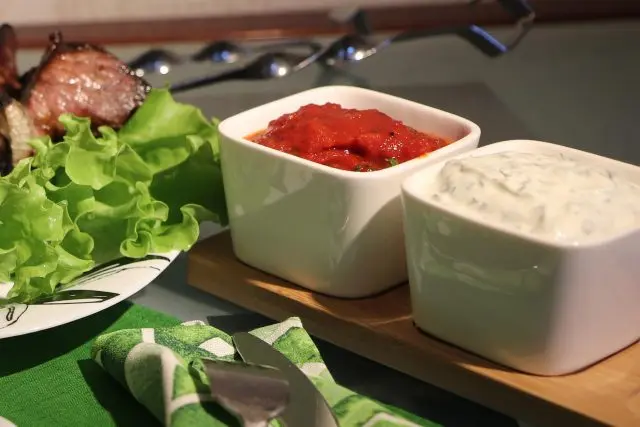
Bakery products
Usually lime is combined with shortcrust or puff pastry.

Pie
Whole lime and lemon are crushed with a blender, add 1,5 tbsp. sugar and boil until thick. A detachable form with a diameter of 24 cm is lined with parchment, ready-made shortbread dough is distributed on it. It is pricked in several places, then baked at a temperature of 180 ° C for 20 minutes.
A mixture of citrus fruits is mixed with 1 tbsp. sour cream, 1 beaten egg and 2 tbsp. l. starch. The cooled dough is filled with a citrus mixture and kept in the oven for about 25 minutes. at 150 °C.
lime cupcakes
For the dough, 100 g of sugar, 90 g of butter, 1 egg, 50 g of milk, 120 g of flour are mixed. Add baking powder at the stage of mixing with flour. Lime juice, 1 tsp the pulp is mixed into the finished composition. Cupcakes are baked for 20 minutes. at 180 °C. For the lime icing, grind the icing sugar with the juice of the fruit until smooth. Cupcakes are decorated with icing, lime pulp.
Some interesting facts about the blood lime
- The locals who first tasted the lime called it “the caviar fruit.” The segments inside the fruit resemble red caviar. When cut, they break up into round red balls.
- Thin peel is the main obstacle for long and long-distance transportation. A slight pressure damages the skin, the pulp seeps out. Producers prefer to transport red citrus frozen: a special type of packaging is used for this.

- Lime of this variety after the appearance and patenting was called “bloody”. French entrepreneurs changed the word “bloody” to “red” so as not to scare off buyers.
- The largest blood citrus plantation is located in Australia, it has up to 1400 trees of this variety. The plantation is owned by Australian farmer Warren McIntosh.
- Australians use blood lime in cooking and cosmetics for the face, hair, body.
- Blood lime cultivation has become popular in South America. There I distribute seedlings brought from Australia.
Conclusion
Blood lime is an unusual and spectacular citrus. It has useful properties and is distinguished by excellent taste. Due to the structural features, it is difficult to transport, so it is not very common in Europe and Asia.










